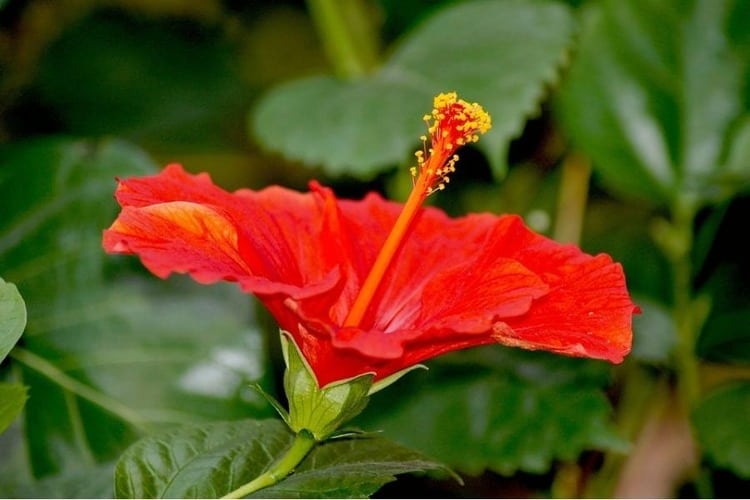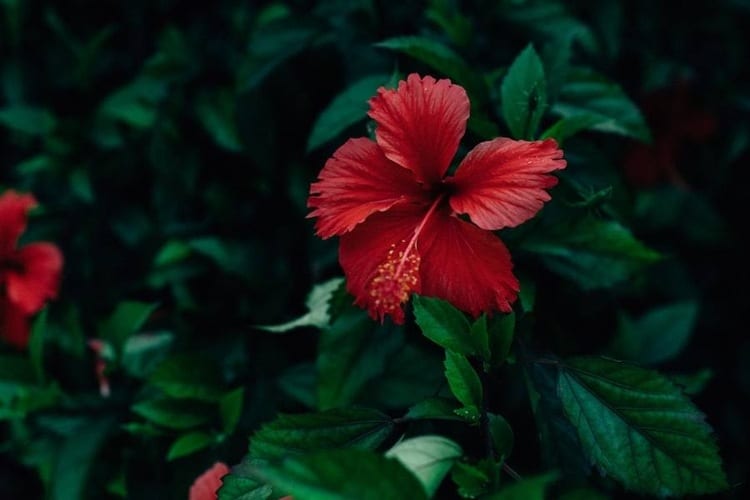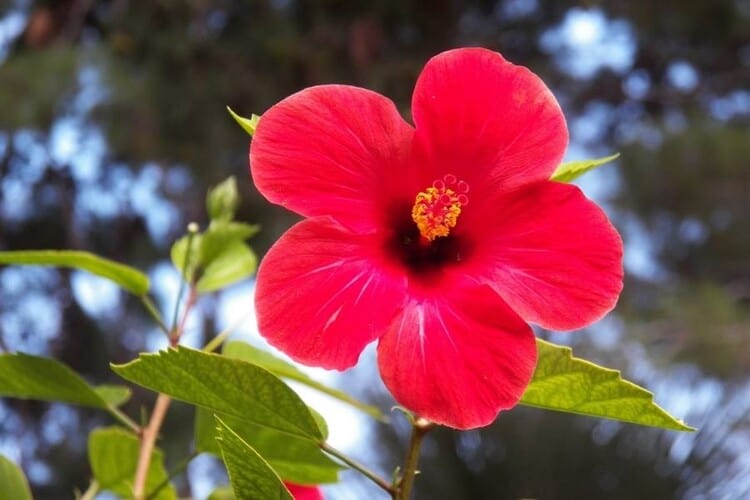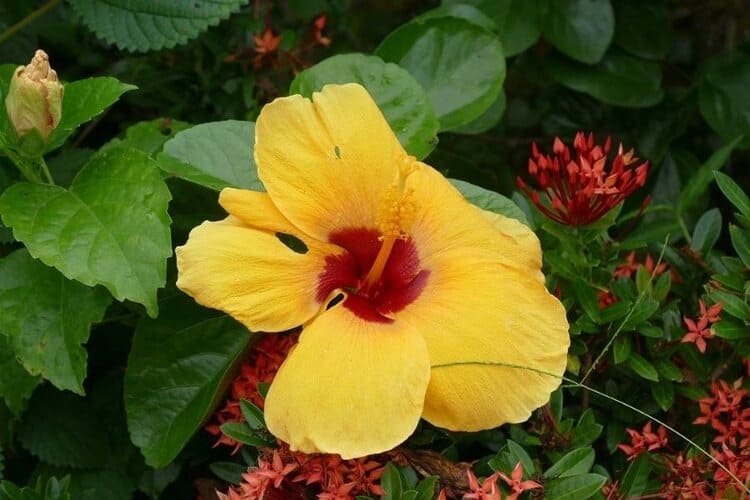Why Is My Hibiscus Not Blooming? (8 Popular Causes)

Hibiscus is famous for its vividly beautiful flowers. Hence, hibiscus not blooming can be a common challenge for planters. There are several factors that can contribute to hibiscus not blooming, such as improper temperature, watering, feeding, light, or humidity. You can also blame the pests on plants.
We will give you an in-depth explanation of poor hibiscus and how to solve each problem. Let’s read on and take note of the ultimate caring tips!
Why Is My Hibiscus Not Blooming?
The main reasons why hibiscus is not blooming are the lack of nutrients, light, and water. There are two main types of hibiscus:
Tropical and hardy. Tropical hibiscus flourishes in warm climates. Meanwhile, hardy hibiscus (or hibiscus spp) thrive in cold environments and withstand bitter conditions.
People prefer growing the tropical variety because it’s evergreen. As a result, we will focus more on it in this post. When your hibiscus plant doesn’t bloom or has dead flowers, it may indicate an issue with the growing conditions.
Temperature
Let’s start with the best temperature for your plant’s growth. As a tropical plant, the hibiscus loves warm conditions. For tropical hibiscus to develop healthily, the temperature should be between 60 and 95°F. While hibiscus plants can tolerate temperatures as low as 50°F, this is not ideal for their growth and blooming.
Besides, although the hibiscus plant likes warm weather, it can’t endure when the summer turns too hot. You should anticipate that the plant will suffer if the temperature rises beyond 90 °F. Since the plant is sensitive to temperature, it can’t bloom if you don’t provide the proper conditions.
How To Solve It?
When the temps drop too low, it’s best to bring your hibiscus indoors and keep it well-heated. If you do this, make sure to bring it indoors before the first frost comes. Otherwise, it will eradicate your flowers. Keep the plant in a warm, bright location and take it outside when the temperature rises beyond 50°F. Nevertheless, be aware that it is preferable to take things slowly when relocating the plant outside.
Allow your hibiscus plant to adapt entirely before returning it to its natural setting. You could, for example, leave it outside for a few hours each day and then take it back inside. Repeat this process for a few days until your plant has fully adapted, and gradually increase the length of time you keep it outside each day. The plant will gradually get used to it and start to grow and bloom as usual.
Watering
You should know about the hibiscus plants, which are pretty thirsty. If you want them to bloom correctly, ensure they get enough water. While older hibiscus bushes may not demand as much frequent watering, potted and younger shrubs need you to water them more often.
Unlike mature plants, the young and potted ones have to moisten the soil to ensure their health. Then they can bloom. Also, please note that the moisture retention capacity of sandy soil is low. If your soil contains many stones or sand, it will drain too quickly. As a result, the roots quickly absorb moisture, causing drought stress and perhaps reducing blooming.
How To Solve It?
If you keep your hibiscus plant outside in a container, water it regularly, ensuring the soil is consistently moist. When the hot summer comes, increase the water amount. Also, make sure that you saturate the soil thoroughly. Then, water can flow out of the holes. More importantly, when all of the extra water has drained out, remember to clear the drip tray carefully.
Overwatering is also a big issue to deal with when planting hibiscus plants. You’ll need to utilize your sense of touch for this. Before watering, check that the top surface of the soil is still dry. If the upper surface is wet, it is best to refrain from watering until the soil has dried out slightly.
Because the hibiscus plants, as previously said, need a lot of water, you should water them regularly. You should also use soil that drains well. If you’re keeping your hibiscus plant in a container, there should be plenty of drainage holes on the bottom so that any extra water can escape.
Light conditions
Tropical plants, including hibiscus, require ample sunlight to thrive. If you love hibiscus flowers, try to give them full-sun illumination. Hibiscus plants can blossom if they receive plenty of sunshine and all other criteria are satisfied.
Otherwise, they may suffer from the lack of light. Then, you will keep them for weeks or even months without any flower buds.
How To Solve It?
If you’re going to keep it outdoors, allow it to get enough sunshine throughout the day. Unfortunately, there will be times when this setup is not possible. It’s hard to find a spot that receives sunshine all the time. But do not panic! You should place the hibiscus plant in a location where it can receive the most direct sunlight.
When you bring the plant indoors during the winter months, ensure it gets plenty of sunlight. Then, when you need to put the plant outdoors again, choose a partially shaded area. Then, gradually increase exposure as time goes on.
A fast transition from indoor illumination to full sun exposure will not be favorable to the plants and may even be detrimental. There’s a potential that your plant will become agitated, leading to leaf shedding or root rot. If the plant is shedding severely, try taking it back inside and letting it acclimatize slowly before reintroducing it to the outdoor environment.
Humidity
Humidity is another factor in determining whether or not the hibiscus blooms. In moderate to high humidity, the hibiscus thrives excellently. Unfortunately, people living in dry climates often have difficulty growing plants. Even when it can develop normally, there are still no gorgeous flowers.
How To Solve It?
You won’t be able to control the moisture if you let the plant sit outside. However, if you bring the pot indoors throughout the winter, you must check the humidity.
There are different methods you can use to improve the moisture levels in your home. Using an electric humidifier should be the most obvious answer given to you. You may adjust the humidity in your room and let the humidifier work. If this method doesn’t work, you can spray the plants gently every few days to keep the moisture high. You may also keep your plant on a stone tray. Then, pour some water on it so that it will gently evaporate as it comes into contact with the rocks and pebbles.
With the passage of time, the plant’s moisture level will rise. However, you should be aware that if your plant reaches a specific height, this method can’t work. The plant’s leaves must be close to the stone tray, and there must be significant spacing between the tray itself and the plant.
You should also check that the water level doesn’t rise over the pebbles since it will stop the water from running effectively via the drainage holes. Hibiscus plants thrive in moderate to high humidity levels. Moreover, it will prevent some problems from arising, such as an infestation caused by spider mites.
Feeding
You’ll need to fertilize the hibiscus plant correctly if you want it to produce flowers from year to year. If you feed the hibiscus plants regularly but they are not producing enough flowers, it might be due to the overabundance of nitrogen in the soil.
Nitrogen is good for plants. However, it focuses on leaf development. As a result, you won’t see any hibiscus flowers. The foliage flourishes when you apply nitrogen-based fertilizers. Unfortunately, this growth comes at the price of the flower.
How To Solve It?
Fortunately, there is no shortage of fertilizers made specifically for hibiscus plants. Likewise, a half-strength, balanced fertilizer can work to get the desired outcome. To make it bloom, paying attention to feeding time is important. You must feed the hibiscus plant every week to ensure that it receives the proper nutrients. A water-soluble fertilizer would be perfect for this.
Water-soluble fertilization is a good option since it guarantees that you can evenly distribute the nutrients throughout the soil. Also, you could want to experiment with a different fertilizer that has a lower nutrient density and a higher potassium content. This ratio is beneficial to the hibiscus plant, and you can notice the results quickly. Furthermore, stay away from fertilizers with a high phosphorus level. It is potentially fatal to your plant.
Pruning
Pruning is relatively self-explanatory, and people who raise flowering plants are already aware of it. To ensure a healthy blossom, you must prune your plants correctly. Timing is also key when it comes to pruning. Hibiscus flowers require new growth; thus, pruning can substantially decrease blooming during the growing period.
Heavy trimming in the early spring might either prevent the plant from blossoming in the summer or severely delay flowering. If flowering delays occur, the hibiscus flower buds may emerge when the weather gets cooler in the fall instead of the summer.
How To Solve It?
Pruning the hibiscus will keep the plant healthy and encourage new development, particularly if any dead blooms need to be cut. Damaged or dead leaves are common, and they don’t look nice. They’re a natural part of the pruning procedure, so cut them out as you go.
These are just a few of the numerous things you’ll need to undertake to keep your plant strong and flourishing. If you take good care of your hibiscus plant, you’ll be delighted with a beautiful spring blossom in no time.
Soil
Hibiscus will not blossom if the soil gets flooded. While hibiscus likes wet soil, it also has to be well-draining. If the soil is thick clay or compressed, and water collects around the root system, the plant will become stressed and will not flower. The soggy soil also encourages the spread of fungal infections like root rot or bud drop, which can kill your plant.
How To Solve It?
Stop watering if the soil seems too wet or looks soggy to give the soil surrounding the root some time to dry out. Tropical hibiscus cannot thrive healthily in saturated soils like thick clay. Hence, transplant it to a well-draining place or into a container.
It’s best to grow the hibiscus in containers, pots, or raised beds. These settings work better for it. You may also adjust the soil profile for potted hibiscus to ensure that it grows and flowers healthily. Fixing marshy garden soil is significantly more challenging.
Pests
Hibiscus are generally resistant to disease and pests. However, if your plant is under any stress, the danger of infections that cause flower buds to die or bloom incorrectly increases.
The causes of stress when growing hibiscus may be:
- Boggy soil or drought
- Too much feeding
- Poor soil
Besides, too much nitrogen may cause succulent foliage development, attracting insects such as bugs, thrips, aphids, or spider mites.
How To Solve It?
Check the leaves for signs of pest infestations and apply an organic pesticide made from neem oil if necessary. Neem oil is safe for other species in your yard and can help you get rid of your pest problems.
It usually takes two or three applications of the spray to clear an infestation. Your hibiscus can’t recover in time to blossom this year, but it will stay healthy and bloom the following year by controlling pests.
Tips To Make Hibiscus Plants Bloom
Aside from the method discussed above, you can apply extra tips to boost your plants to bloom time.
Fertilizing
Try to feed your plant every two weeks. You can combine water-soluble fertilizers with slow-release ones. Apply an N-P-K fertilizer with a high last value to promote more flowering. Using organic fertilizers like banana peel, onion peel, or bone meal is also advised.
Repotting
Repotting is a popular method for encouraging blooming. It will also strengthen the hibiscus. You can grow the plant in pots ranging from 4 to 16 inches in diameter. Once roots started to emerge from the pot, it was time to repot the hibiscus.
If you want to repot the plant, submerge it in water for three to four hours to loosen the dirt around it, then cut the roots to give the plant a stimulus. Use the potting mixes and repot your hibiscus in the next larger pot to provide it with more space to thrive. It’s ideal for growing your hibiscus in a bigger pot. You can choose a wider container than the first pot, but not too deep.
Climate
Because this plant is native to the tropics, a humid and hot environment is perfect for growing it in a container or in the ground. You should choose a spot where the temperature stays between 60 and 95°F. Flowers need two hours of sunshine and a maximum of eight hours of sunlight for maximum blooming.
Conclusion
When the hibiscus doesn’t bloom, it indicates that you have not taken care of it correctly. In this case, check the growing condition and fix the problems immediately. Your cropping will become much easier once you know the plant’s characteristics. Bear in mind our tips, and you will have a plentiful harvest. Hopefully, you will find this article helpful. For any further information about gardening tips, please feel free to ask. Thank you for reading!




